
星空间将参加“艺术北京2012” Press Release: Star Gallery to Participate in “Art Beijing 2012”
展览时间:2012年4月29日—5月2日
Duration: April 29th — May 2rd, 2012
展览地点:北京•全国农业展览馆
Address: Agricultural Exhibition Center of China, Beijing
1
经过6年的成长与磨炼,“艺术北京”已成为亚洲地区规模最大的艺术博览会,并成为政府重点扶持的北京文化创意产业高端项目。2012年艺术北京秉承“立足本土,完整亚洲”的理念,进一步深化与中国本土画廊的合作,并将触角伸向亚太地区和欧美国家的画廊,以期多角度地呈现不同国家和地区在文化上和艺术创作上的差异性。
与“艺术北京”同期成长起来的星空间,在这个每年一度的艺术盛事上占据着越来越重要的位置。2012年4月29日至5月2日,星空间第3次率自己的艺术家参加“艺术北京”博览会,在当代馆靠近中心的地带占据了两个展位。(展位号:B5&B6)。星空间在本届艺博会的主题是“不在/不再”,代表了这次送展的艺术家新作的某种共性,这两个词汇代表时间和空间上的两种状态,而本质上仍是新一代艺术家关于情感、价值观和生存状态的表达。
星空间将带来7位艺术家的9件新作参加本届博览会,分别是:韦嘉的绘画作品《嘲风》,高瑀的《自刎——再见!》,邱炯炯的绘画作品《中秋图》、《醉归图》,金钕的雕塑作品《冷光》系列之五,徐毛毛的绘画作品《焦虑的女人》,文川的绘画作品《呼吸》、《伙伴》,王一凡的影像装置《世界之初》。
届时,还将呈现L.A.B.艺术衍生品系列,包括高瑀、陈可、陈飞的共5款版画,以及陈飞的1件艺术玩偶,为不同层面的艺术爱好者,特别是同龄人提供与艺术近距离接触的初体验。
此外,在“艺术北京”期间,星空间将在画廊空间举办平行展览“致劳动节——非典型劳动者的劳动典型”,展示生活在黑桥和宋庄的几位青年艺术家非常具有实验性的装置作品,展览将在艺术北京博览会开幕前夕揭开神秘的面纱。开幕式将于4月27日下午两点在星空间举行。
2
高瑀正在紧张地准备年底的大型个展。此次展出的《自刎——再见!》,主题和接下来的展览有延续的关系,而材质和制作上则是他去年着手研究的新创作手法的延展。
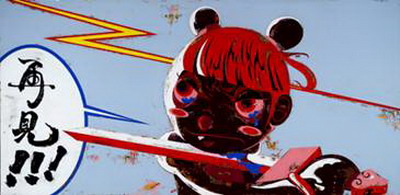
高瑀 Gao Yu 《自刎——再见!》Nezha Commits Suicide 160 × 330cm 布面丙烯 Acrylic on canvas 2012

陈飞 Chen Fei 《小武基》 Xiao Wu Ji 180 × 240cm 亚麻布、丙烯 Acrylic on flax canvas 2012
艺术家阐释:“小武基是北京的一个城乡结合部,我偶然逛到这个地区的一个综合市场,惊奇地发现在2012年的北京,小武基还是像80年代那样灰砖青瓦,仿佛时间静止了一样。我想,生活可能没有我们想象的那么好。这张画画得是一个郁郁不得志的女孩,她有可能很有理想,不安于现状,但迫于种种的无奈,只能在小武基这个地方做着自己不喜欢的工作,求得基本的温饱。我画的是她,也是我。”
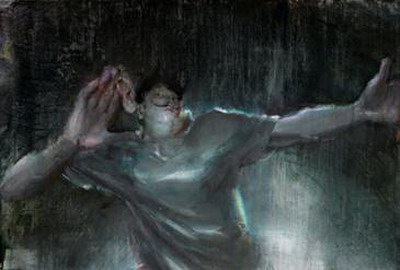
韦嘉 Wei Jia 《嘲风》Chaofeng (The Third Son of the Dragon) 60 × 90cm 布面丙烯 Acrylic on canvas 2012
艺术家阐释:“这件作品没有意义也没有故事,来源于一张足球运动员进球后聆听欢呼的图片,他的生命状态很吸引我。嘲风是传说中龙的儿子,好险又好望,形象常用于殿角之上。我就很想用这样一个名字。”
作为去年在尤伦斯举办的个人影展的延续,邱炯炯的5部电影正在全国十余城市参加“齐放”——独立电影的巡回联映活动。而影展过后,邱炯炯积蓄的能量喷薄而发,在绘画创作上迎来了一个新的高峰。邱炯炯的题材性一直以来令喜欢其画作的人津津乐道,今年则向着更广更深发展。
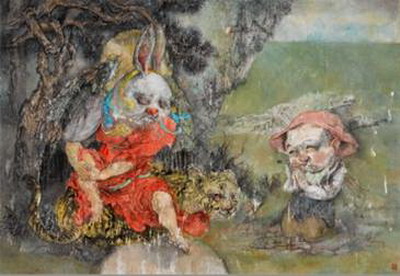
邱炯炯 Qiu Jiongjiong《中秋图》Mid-Autumn 122 × 176.5cm 纸本设色水墨 Ink and color on paper 2011
阐释:《中秋图》中,地方传说中以仙药治病救人的兔爷儿,同时也是某种不平等关系中高高在上的那位。兔爷儿骑虎而坐,仿佛是一切希望的来源,叼着画笔跪拜的小人物影射创作中无灵感的艺术家。也许艺术家的缪斯就是一个“土气”的兔爷儿,而民间正是他创作的本源。

邱炯炯 Qiu Jiongjiong 《醉归图》Going Home Drunk 110 × 110cm 纸本设色水墨 Ink and color on paper 2011
阐释:《醉归图》画的是一个月黑风高夜,两个微醺的孩童背着一只大醉的熊猫踉跄回家的场面,画面的形成和艺术家天人合一的思想有关。
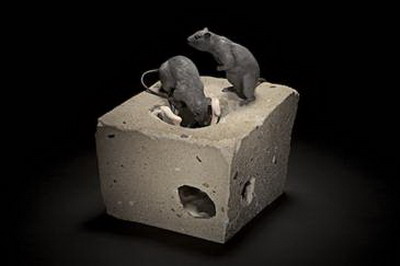
金钕 Jin Nü 《冷光 5》 Luminescence No. 5 43(H)× 34 × 34cm 树脂着色,水泥 Resin stains, cement 2011
艺术家阐释:“孤独是人类与生俱来的伤感,从生来到死去,都是一个人面对。活着的时候,每个人也要经历各种不同形式不同境况下的孤独。作品《冷光》表现的就是日常生活中的孤独片段。《冷光》是一个系列作品 ,已完成作品五件 。主角时而趴在巨大的餐桌上面对着美味佳肴无从下口,直到它们变成残羹冷炙;时而蹲坐在柜顶上把自己逼近墙角,寻求保护,或是在梦魇中不断下坠,包裹她的是无尽的黑暗与冰冷的水泥。定名为《冷光》,是因为挂在头顶的日光灯发出的惨白的光线一直晃在我最孤独的记忆中。”
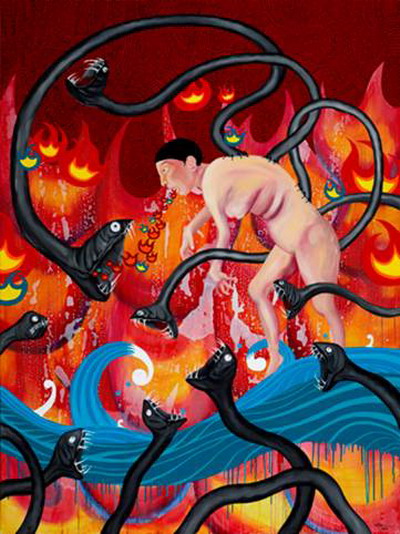
徐毛毛 Xu Maomao 《焦虑的女人》An Anxious Woman 200 × 150cm 布面丙烯 Acrylic on canvas 2012
艺术家阐释:“这幅画表现了人们处在焦虑时的一些状态。长得像蛇一样的鱼代表了一种在焦虑时自身想要爆发的欲望,在挣扎的时候从身体里迸发出来。而火焰象征一种情绪,和欲望交织在一起产生了更大的焦虑,现代社会里的人们往往在这个时候还要压抑自己,流动的水和黑色的整齐的有规律的点点是想表现徒劳的理智和克制。”
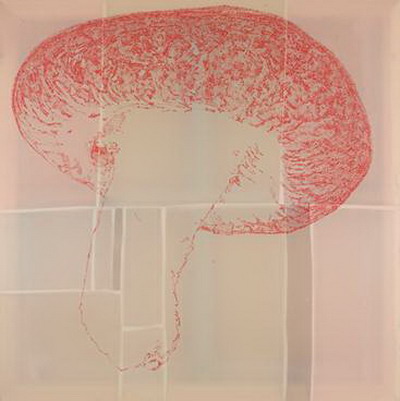
文川 Wen Chuan 《呼吸》 Breathing 90 × 90cm 布面丙稀 Acrylic on canvas 2012
艺术家阐释:“我倾向于采用一种冷幽默的方式处理绘画中符号、观念与视错觉之间的戏剧关系。希望能够调动画面全体因素——物理材质、绘制风格以及主题内容的相互作用,在作品中构建一种微妙的心理关系。正如培根所说的‘不可能讨论画,只能围绕画说点什么’,我宁愿自己的作品无法被确切地描述和解释,因为它们与情感和想象有关,而这种对爱的渴求,以及如影相随的孤独和无力感注定只能在隐约间被折射与被捕捉。‘蘑菇’在这一系列作品中被更多赋予‘人性化’特征。一只红色蘑菇独占了由若干块不同颜色布料拼接而成的半透明画布。和亚麻画布材质所不同的是,半透明的聚酯画布在质感上显得缺乏‘温度’。对菌盖基于现实光影的密集描绘让人有种肿胀的感觉,这与菌柄的简单勾勒形成了一种视觉和情感上的变化和刺激。”
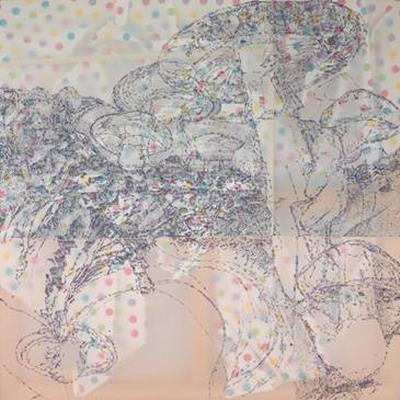
文川 Wen Chuan 《伙伴》Companion 90 × 90cm 布面丙稀 Acrylic on canvas 2012
艺术家阐释:“《伙伴》源自对《白雪公主和七个矮人》的情欲化想象。画面中并没有具体的人物形象出现,而仅仅通过对一只手的描绘,以及画面下方的若干弧线来暗示出身体的存在。蘑菇在此处象征了一种不确切的情感依靠,它们寄生在画面各处,仿佛在伺机填补任何一个可能的空隙。半透明聚酯画布后透出的多褶彩色圆点幕布为这个私密场景增添了迷幻色彩,而画面中的手势并不能确切地提示出蘑菇和身体间到底是主动还是被动,阻止还是迎合的关系。”
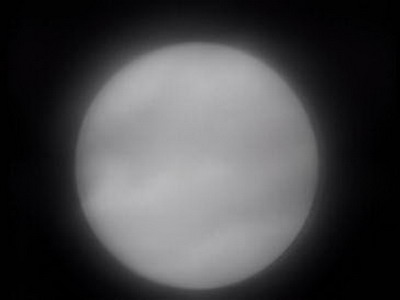
王一凡 Wang Yifan《世界之初》The Beginning of the World 58:06:58 录像装置 Video Installation 2012
艺术家阐释:“在《世界之初》里,我先后10次录制了北京天文馆天文望远镜的太阳监控影像,太阳以10个不同的面貌被存入硬盘,变成了10个独立存在的数字格式的太阳。这10部DV同时播放,象征中国古人对天空有十个太阳的猜想,再现了后羿射日这个神话传说中,世界之初的幻象。
童年阶段我就怀疑过‘眼见为实’,为此在后来的学业中我关注哲学并试图寻找答案。分析后羿射日这个传说,触动我的并非是人类由于时代或位置分离造成的禁区,而是人类全体对真实二字的跪求。换句话说,曾认为有十个太阳的人和曾否认有十个太阳的人,他们肩负的是同一个使命。这样问题就来了,我对真实的思考是没有结果的。为了能尽量的贴切,也为了化解长期无缘得见真实造成的焦虑,我试探着用科学的手段去描述神话式的判断。”
1
After six years of growth and maturation, Art Beijing has established itself as one of Asia's most influential art fairs. Today, it is a high-end cultural and creative project that enjoys tremendous support from Beijing's municipal government. With this special 2012 exhibition Art Beijing builds on its ‘locally based and Asia-oriented’ concept to further deepen its cooperation with local art galleries in China, galleries throughout the Asia-Pacific region, and galleries in the United States and Europe in an effort to engage a range of perspectives in showcasing the cultural, creative, and artistic diversity across countries and regions.
Star Gallery has accompanied its own artists in attending Art Beijing three times, with two booths (B5 & B6) in the center of the Museum of Contemporary Art. This year, Star Gallery comes to Art Beijing with “Not Here/ Not Ever,” a theme that speaks to common threads shared by the selection of new works Star Gallery's participating artists have entered. The duality of the theme highlights temporal and spatial dimensions of experience, but it is also most essentially an expression of the emotions, values, and survival modes of a new generation of artists.
Star Gallery brings nine new works from seven different artists to this year’s Art Beijing: Wei Jia's “Chaofeng (The Third Son of the Dragon)”, Gao Yu's “Nezha Commits Suicide”, Qiu Jiong Jiong's paintings “Mid-Autumn” and “Going Home Drunk”, Jin Nu's sculpture “Luminescence No.5,” Xu Maomao's painting “An Anxious Woman,” Wen Chuan's paintings “Breathing” and “Companion”, and Wang Yifan's video installation “The Beginning of the World”.
Art Beijing will also mark the official launch of L.A.B art derivatives. This time around, L.A.B will release five prints from Gao Yu, Chen Ke, and Chen Fei, as well as one art doll from Chen Fei. Geared especially at our younger peers, this is Star Gallery's effort to give art lovers and consumers at all levels of engagement with the art world a chance to start establishing their own collections and to gain more intimate access through affordable works of art.
In addition, Star Gallery will hold a parallel exhibition throughout the duration of Art Beijing titled "To Labor Day: The Fruits of Unconventional Labor," which will showcase the truly experimental installation work of a group of young artists from Heiqiao and Songzhuang art districts, to be unveiled after much anticipation on the eve of the larger art festival. Art Beijing's opening ceremony will be held the afternoon of April 27 at Star Gallery.
2
Gao Yu is currently immersed in frenzied preparation for his large-scale individual exhibition at the end of the year. His “Nezha Commits Suicide” extends out of his upcoming exhibition and represents a continued deepening of a new creative practice in terms of material and production which took root last year.
高瑀 Gao Yu 《自刎——再见!》Nezha Commits Suicide 160 × 330cm 布面丙烯 Acrylic on canvas 2012
“‘Nezha Commits Suicide’ is inspired from an animated film that will be very familiar to children born in the 70s and 80s- ‘Nezha Disturbs the Ocean.’ This kind of story often has several unifying traits: they almost all star adolescent boys, most of whom for various reasons don’t have a mother or a father; all are possessed of some kind of mission; they have an enemy they must vanquish and after some setbacks experience a twist of good fortune that allows them to finally defeat their enemy. This kind of structure is embedded in ‘Nezha Disturbs the Ocean’ in precisely the same way- the suicide completely destroys the father’s authority, there are pitfalls and triumphs, ordinary embryos are discarded in favor of a completely new birth. The fire tipped gun, the flaming chariot, the attack on the imperial court: these plot elements are brimming with connotations of the Cultural Revolution, and inspired me to create three scenes: ‘Nezha Commits Suicide’ /‘ Rebirth—Everything is Brand New’ / ‘Noisy Sea- No Creation Without Destruction’. I want them to introduce a new perspective and help to educate us on the history and the course of events that molded the personalities of people from this era. ”
——Gao Yu
陈飞 Chen Fei 《小武基》 Xiao Wu Ji 180 × 240cm 亚麻布、丙烯 Acrylic on flax canvas 2012
“Xiao Wu Ji lies at the intersection of the city of Beijing and the countryside, and I occasionally stroll by and stop at its supermarket. Xiao Wu Ji seems surprised to discover the Beijing of 2012- it’s still using the grey cement and green roofs of the 80s; it’s as if time has stood still. I like to think that we can’t possibly imagine a life that good. This piece depicts a girl who cannot aspire to be elegant, she has many dreams and isn’t content with the status quo, but she’s helpless under all kinds of restrictions. All she can do is work at things she doesn’t like in Xiao Wu Ji just seeking basic nourishment and shelter. I’m painting her but also painting myself.”
——Chen Fei
韦嘉 Wei Jia 《嘲风》Chaofeng (The Third Son of the Dragon) 60 × 90cm
布面丙烯 Acrylic on canvas 2012
“This piece has no explanation, no meaning, and no story. It originates from a photo of a crowd cheering after a goal was scored by a soccer player, the state of his life was very interesting to me. Chao Feng is the third son of the dragon in traditional Chinese folklore, he’s dangerous and hopeful, with the above image commonly used to depict him. I really wanted to use this image.”
——Wei Jia
Qio Jiongjiong's five films, growing out of his work on his solo film exhibition at Ullens Center for Contemporary Art last year, are currently being shown as part of the “Cinephile Collective” Independent Film Tour in over ten cities across China. Riding on his energy from the film festival, Qiu Jiongjiong has reached a new height in his painting. Fans of his works always delight in discussions of his themes, but this year he probes even deeper.
邱炯炯 Qiu Jiongjiong《中秋图》Mid-Autumn 122 × 176.5cm 纸本设色水墨 Ink and color on paper 2011
In “Mid-Autumn”, the Chinese folklore character Old Man Rabbit is using traditional medicine to cure an illness while simultaneously having an unfairly advantageous position, sitting high and remote above his subject. Old Man Rabbit is riding a tiger, with the tiger appearing to be the origin of his power. The tiger holds in its mouth a paintbrush that is being worshiped on bended knee by the small person, insinuating that the artist possesses no real creativity of originality. Perhaps the artist’s muse is a “rustic” rabbit, one whose creativity originates from his associations with the common people.
邱炯炯 Qiu Jiongjiong 《醉归图》Going Home Drunk 110 × 110cm 纸本设色水墨 Ink and color on paper 2011
The painting “Going Home Drunk” shows a dark, windy night, and the spectacle of two tipsy children staggering as they carry a drunken panda home. It’s related to the artist’s opinion that the form and the artist parallel the oneness of heaven and humanity.
金钕 Jin Nü 《冷光 5》 Luminescence No. 5 43(H)× 34 × 34cm 树脂着色,水泥 Resin stains, cement 2011
“Loneliness is humanity’s inherent sentiment- from birth to death it is something we must face. When we speak of it, every person’s loneliness takes different forms and has been experienced in different circumstances. The piece “Luminescence” expresses a fragment of the loneliness of everyday life. The leading figure occasionally lies on an enormous table, opposite a mass of delicious food that he can’t eat, until he himself becomes leftovers, occasionally crouching on the cabinet, pressing himself into the corner, seeking protection, either that or the risk of facing a fall into an endless nightmare, as if he’s being wrapped in an inexhaustibly dark and cold cement. The name ‘Luminescence’ was chosen because the ray of deathly pale light emanating from the top of its head always dazzles in the memory of my own loneliness.”
——Jin Nü
徐毛毛 Xu Maomao 《焦虑的女人》An Anxious Woman 200 × 150cm 布面丙烯 Acrylic on canvas 2012
“This painting depicts people caught in an anxious situation. As I was painting it I too was maybe in an anxious place in my life. The fish that resembles a serpent represents the longing to explode that often occurs in anxious situations, an impulse that erupts from the body during times of struggle. In contemporary society people living through this kind of anxious situation often repress themselves. Flowing water and neatly ordered black dots depict this futile intellectual restraint.”
——Xu Maomao
文川 Wen Chuan 《呼吸》 Breathing 90 × 90cm 布面丙稀 Acrylic on canvas 2012
“I’m prone to using a kind of black humor when making my paintings, exploring the drama between an optical illusion and a concept. The hope lies in the ability of the picture to transform its own physical elements, drawing the interplay between the style as well as the subject matter, and to construct a type of subtle psychological relationship. Just as Bacon said: ‘We cannot discuss paintings, just the point of them,’ I would rather my own work to be incapable of exact description and definition, because they are to do with emotion, and moreover they crave love, and in addition the loneliness and weakness of the image is doomed to be only fleetingly captured.‘Mushroom’in this series has more human characteristics. A giant red mushroom monopolizes the canvas with a variety of translucent colors. The materials differ from those used in a flax canvas, with the translucent polyester canvas lacking a certain textural ‘heat’. The concentrated portrayal of light and shadow on the mushroom’s cap inspires people to brave an onslaught of bruising emotion, the simple outline of the mushroom and its stalk creates a visual and emotional change of provocation for the viewer. ”
——Wen Chuan
文川 Wen Chuan 《伙伴》Companion 90 × 90cm 布面丙稀 Acrylic on canvas 2012
“‘Companion’ originates from a sensual reimagining of ‘Snow White and the Seven Dwarfs’. In the piece, there are no recognizable human forms, with only the slightest appearance of a hand and moreover there is only the slightest arc underneath the piece to suggest the appearance of a body. The mushroom symbolizes an imprecise definition of dependence, they live as a parasite all over the piece, awaiting a chance to seize opportunities and filling the crevice. The multi-colored dots and pieces passing through the polyester canvas complement the semi-conscious character of this piece. However, the gestures of the piece cannot precisely define the ultimate passivity or activity between the mushroom and the body, with this impediment between them catering to the depiction of their relationship.”
——Wen Chuan
王一凡 Wang Yifan《世界之初》The Beginning of the World 58:06:58 录像装置 Video Installation 2012
“In ‘The Beginning of the World’, I recorded in succession 10 images of the Beijing Planetarium’s solar monitoring, storing on a hard drive ten different images of the sun. Each one then became an independent form of the sun itself. When these 10 images are simultaneously broadcast, they resemble the ten auspicious images of the sun as known to the Chinese ancients and reconstruct the folklore legend of Houyi’s shooting of the sun which was the illusion of the beginning of the world.
As a child I was skeptical that ‘seeing was believing’, and as a result paid special attention to philosophy in my studies in order to find answers to these questions. I realized after analyzing the fable of Houyi shooting the arrow, that what really moves me isn’t the taboos that humanity smashes according to time or circumstance, but is actually the search, the kneeling before these two poles of thought. In other words, once people believe that there are ten people in the sun or once they believe that there aren’t ten people in the sun, they’re still shouldering the identical philosophical mission. In order to give the closest approximation, as well as in order to dissolve the anxiety that we don’t have the good fortune to avoid in the long term, I am trying to use scientific method to describe the decisions found in myths.”
——Wang Yifan
媒体垂询请联络:
星空间公共事务部媒体专员 孟玥辰
电话:(010)5978 9224
邮箱:pr@stargallery.cn
For inquiries please contact:
Public Affairs Dept. of Star Gallery Media Specialist
Meng Yuechen
Tel: (010)5978 9227
Email: pr@stargallery.cn

![[北京]时代美术馆“楼上的青年: 2010青年批评家提名展”](attachment/100601/48ac4fdc6c.jpg)